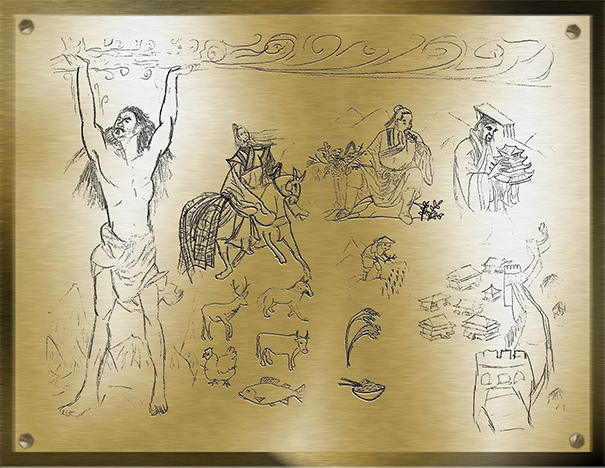| Time Period | Creation and Myth |
| Geographical Region | Yellow River Valley “Cradle of Chinese Civilization” |
| List of Symbols |
|
Civilization and culture have always been hallmarks of Chinese society. The Chinese prided themselves based on their development and sophistication compared to their barbaric neighbors. China is called the Middle Kingdom partly because they saw themselves as the most powerful civilization compared to those around them. The creation myth describing how they came to be the most powerful society is central to Chinese identity. The genesis of the world through Pangu has underscores of Chinese values, such as Yin and Yang, which would be present throughout future generations of dynasties. The Sage kings each introduce a foundation of Chinese civilization; China would not exist without the qualities brought forth by the great Sages. While the actual existence of Pangu and the Sage kings is up for debate, the existence of the qualities they symbolize is as concrete as the Earth. By examining the characteristics of the creation myths, we can see what makes Chinese civilization the great power that it is.
Pangu, the figure on the far left reaching up with both hands, is central to the Chinese creation myth. According to legend, the world started as intermingled chaos of Yin and Yang, forming a giant cosmic egg. Within the egg, a huge giant named Pangu grew and slept for 18,000 years. Upon awakening, he broke free from the egg and pushed upwards. As he pushed, he separated the top and bottom halves of the egg, each to become Heaven and Earth respectively. The separation of Heaven and Earth marked the beginning of the balance of the two forces Yin and Yang. Resolved to prevent the chaos from the two forces from mixing, Pangu continued to grow and to push the sky further upwards above the earth. After 18,000 years of continual growth and pushing, the sky was stably separated from the earth and Pangu died. His arms and legs became the four directions. His breath transformed into the wind, clouds, and thunder. His blood formed the oceans and his sweat formed the rain. His eyes made the sun and moon. His flesh and bone created the vast terrain of the earth. And the parasites living on his body became humans. Pangu is an important element of Chinese creation myth because he is the genesis of nature. The idea that humans were just simple parasites while the forces of nature are given more attention is an enduring aspect of Chinese culture; later Chinese schools of thought sought to reconcile man with his surroundings.
Chinese civilization myths begin with three sage kings who created the basis of Chinese society. They ruled from about 3000 – 2000 BCE. The first of these kings was Fu Xi, the subduer of animals. Fu Xi is the figure directly to the right of Pangu riding a horse with a net in his hand. Fu Xi gave the Chinese people nets and baskets to hunt and fish. He domesticated animals, shown below him on the plaque. By establishing dominance over animals, Fu Xi founded the superiority of mankind.
The second sage king was Shen-nong, the Divine Farmer, drawn as the figure third from the left, directly to the right of Fu Xi. Shen-nong gave the Chinese agriculture. He invented the rake, plough, and sickle and taught how to farm plants such as rice, drawn below the seated Shen-nong. He also taught people how to trade and barter using markets. Shen-nong is most famous for documenting the effects of every herb by eating them. He extensively studied the medicinal properties of the many plants of the world. According to legend, he had a transparent stomach, which he used to see the effects of all the herbs he consumed. In the plaque, he is drawn tasting different herbs. Shen-nong ultimately died from the cumulative poisons of the herbs that he consumed. Shen-nong’s legacy is that he furthered Chinese society past the simple hunter and gatherer state.
The third sage king was Huang-di, the Yellow Lord, drawn as the figure on the far right of the plaque. Huang-di brought peace to China by subduing the barbarians and gaining the allegiance of the powerful lords. In later Chinese history, Huang-di is seen as the paragon of leadership. He appointed many talented advisors and demonstrated good management skills by utilizing the skills of the men that served him. The period of peace that he brought ushered in an age of civilization and growth of Chinese culture. His reign is credited with the development of the written language, astronomy, mathematics, the calendar, Chinese Traditional Medicine, improved construction of buildings, a code of written laws, and silk-making. On the plaque, the Yellow Lord is drawn constructing civilization. Beneath him sits civilized China, separated from the barbarians by a wall (not the Great Wall of China which was yet to be constructed).
The Three Sage kings were idealized by later Chinese thinkers and rulers as a period of divine rulers. Confucius referred to them as paragons of leadership. During the Three Kingdoms period and early Han dynasty, the Yellow Lord was seen as the ideal ruler and the Tang dynasty claimed to be descended from the Yellow Lord.
The figures portrayed on the plaque symbolize the essence of Chinese civilization, from creation through balancing the forces of nature and man’s small place in the world to moving from a hunting and gathering society to a society with a written language, rich culture, and immense strength. Any future dynasty depended on China’s strong farming foundation and written language applications such as civil service examinations.

ISAAC WONG is a freshman at the University of Rochester who plans to major in microbiology. Isaac is from Phoenix, Arizona and is happy not living in a desert. He is on the university’s club volleyball team. More by Isaac
